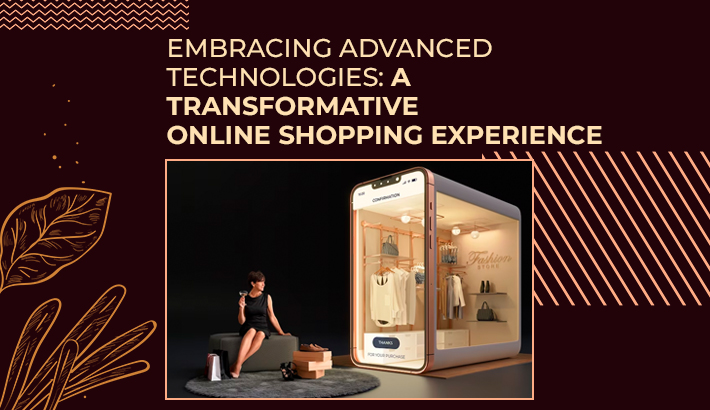The landscape of online shopping has been continuously evolving with the advent of advanced technologies. These innovations have reshaped and revolutionized the way consumers browse, select, and purchase products online. In this article, we will explore the exciting advancements that have transformed the online shopping experience, making it more seamless, personalized, and accessible than ever before.
1. Artificial Intelligence (AI) - Personalized Recommendations
AI has taken center stage in online shopping, enhancing the customer experience through personalized recommendations. By analyzing consumer behavior, preferences, and purchase history, AI algorithms can suggest products tailored to an individual's unique tastes. This level of personalization not only improves customer satisfaction but also increases sales conversion rates for businesses.
Moreover, AI-powered chatbots provide real-time customer support, answering queries and offering product recommendations. These virtual assistants contribute to a more interactive and efficient shopping experience, reducing the need for human intervention.
2. Augmented Reality (AR) - Try Before You Buy
One of the biggest limitations of online shopping has been the inability to physically try on or interact with products. However, AR has eliminated this hurdle by overlaying virtual items onto the real world, allowing customers to visualize and experience products seamlessly.
AR technology enables virtual try-ons for fashion items such as clothing, accessories, and makeup. Customers can see how items would look on them before making a purchase, thereby minimizing the risks associated with buying online. This advanced feature has significantly enhanced customer confidence, resulting in increased online sales for retailers.
3. Virtual Reality (VR) - Immersive Shopping Experience
VR has introduced a new dimension to online groceries shopping, providing customers with an immersive and interactive experience. By wearing a VR headset, shoppers can enter a virtual store environment, explore products, and even interact with virtual sales associates.
This technology has great potential for industries like real estate, where customers can virtually tour properties without leaving their homes. Additionally, VR facilitates virtual showrooms for automotive companies, enabling customers to examine car models up-close in a realistic 3D environment.
4. Voice Search - Simplified Shopping
With the rising popularity of virtual voice assistants like Amazon's Alexa, Google Assistant, and Apple's Siri, voice search has gained significant traction in online shopping. It offers a convenient and hands-free way for customers to find and purchase products.
Optimizing websites and product descriptions for voice search enhances visibility and accessibility for voice-activated devices. Consequently, businesses that adapt to this trend can reach a larger audience and increase sales by aligning with changing consumer preferences.
5. Mobile Commerce (M-commerce) - Shopping on the Go
Mobile devices have become an indispensable part of our lives, and M-commerce has transformed online shopping by making it accessible anywhere, anytime. With the development of mobile applications and responsive web design, online retailers have tapped into the vast potential of mobile platforms.
Through mobile apps, consumers can browse products, make purchases, track orders, and receive personalized notifications. This level of convenience has reshaped the online shopping landscape, making it more seamless and integrated into our daily routines.
Conclusion
The continuous evolution of advanced technologies has resulted in a transformative online shopping experience. AI-powered personalization, AR and VR for visualizing products, voice search convenience, and M-commerce accessibility have revolutionized the way consumers interact with online retailers. As these technologies continue to evolve and mature, we can anticipate an even more immersive, convenient, and personalized online shopping experience in the future. Businesses that embrace these advancements will thrive in the highly competitive e-commerce landscape, while customers enjoy an enhanced and enjoyable shopping journey.
FAQ's
Q1: What is AI in online shopping?
A: AI (Artificial Intelligence) in online shopping refers to the use of algorithms and machine learning to analyze consumer behavior, preferences, and purchase history. It allows for personalized product recommendations, chatbots for customer support, and improved overall customer experience.
Q2: How does AR enhance online shopping?
A: AR (Augmented Reality) enhances online shopping by overlaying virtual items onto the real world. It allows customers to visualize and experience products before purchasing, especially in industries like fashion where customers can virtually try on clothing or accessories.
Q3: What is the role of VR in online shopping?
A: VR (Virtual Reality) provides an immersive and interactive experience for online shopping. It allows customers to enter a virtual store environment, explore products, and interact with virtual sales associates. It is particularly useful for industries like real estate and automotive, where customers can virtually tour properties or examine car models.
Q4: How does voice search impact online shopping?
A: Voice search simplifies online shopping by allowing customers to find and purchase products using voice commands. Optimizing websites and product descriptions for voice search improves visibility and accessibility for voice-activated devices like virtual assistants, leading to increased sales and reaching a larger audience.
Q5: What is M-commerce?
A: M-commerce (Mobile Commerce) refers to the ability to conduct online shopping through mobile devices such as smartphones and tablets. It has transformed the online shopping experience by making it accessible on the go, allowing customers to browse products, make purchases, track orders, and receive personalized notifications through mobile applications or responsive websites.
Q6: How do these advanced technologies benefit businesses and customers?
A: These advanced technologies benefit businesses by improving customer satisfaction, increasing sales conversion rates, and expanding their reach. For customers, they provide a more personalized, convenient, and immersive online shopping experience, allowing them to make informed purchasing decisions and interact with products in innovative ways.







Leave a reply